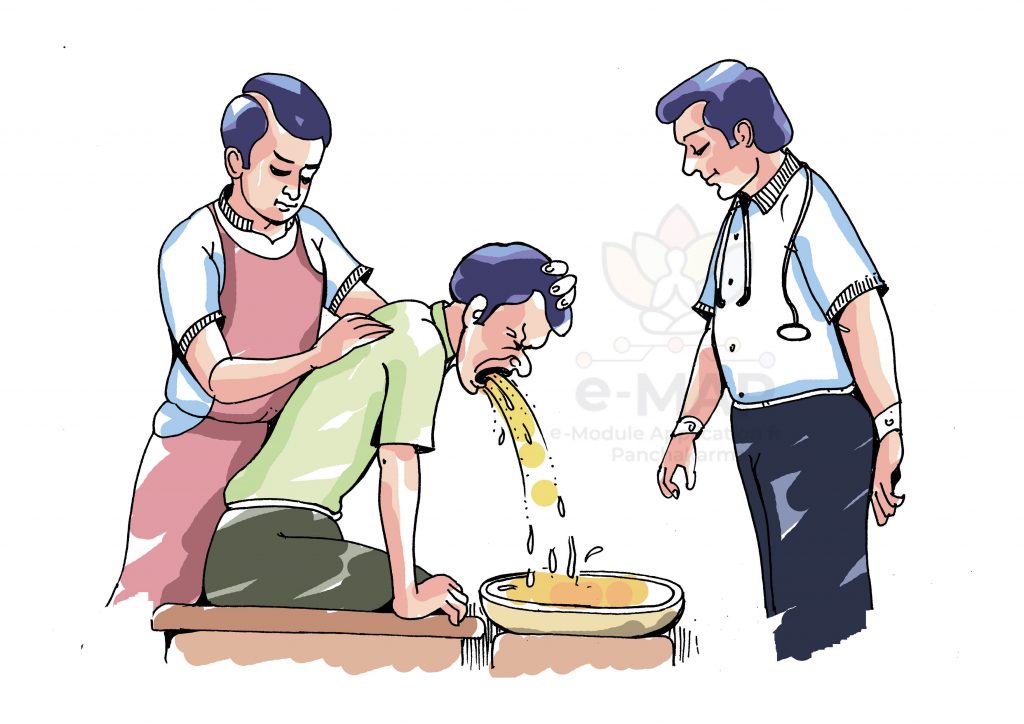
PG Module 4
VAMANA KARMA

EXPLANATORY NOTES
योगःसम्यक्प्रवृत्तिःस्यादतियोगोऽतिवर्तनम्|
अयोगःप्रातिलोम्येननचाल्पंवाप्रवर्तनम्|| (Cha. Si. 6/31)
Samyak Yoga indicates optimum action of elimination therapy, Atiyoga indicates excess elimination, Ayoga indicates insufficient or no elimination.
SAMYAK YOGA LAKṢAṆA
क्रमात् कफः पित्तमथानिलश्च यस्यैति सम्यग्वमितः स इष्टः||
हृत्पार्श्वमूर्धेन्द्रियमार्गशुद्धौ तथा लघुत्वेऽपि च लक्ष्यमाणे| (Cha. Si. 1/15)
In case of a person, expulsion of Kapha, Pitta and Vāta in the succeeding order, who experiencesclarity in chest, flanks, head, sense organs and lightness in the body is considered to haveundergoneproper emesis
निर्विबन्धंप्रवर्तन्तेकफपित्तानिलाःक्रमात्|
(मनःप्रसादःस्वास्थ्यंचावस्थानंचस्वयंभवेत्|
वैपरीत्यमयोगानांनचातिमहतिव्यथा||१|| )
सम्यग्योगे————————————-| (A. H. Su. 18/25)
According to ĀcāryaVāgbhaṭa, SamyakLakṣaṇas of Vamana are expulsion of Kapha, Pitta and Vāta in the succeeding order at the proper time, clarity of mind, bouts starts and stops without inducing, feeling of relief from the symptoms and body becomes light, absence of the symptoms like Niṣṭhīvaetc (opposite of Ayoga Lakṣaṇas)
AYOGA LAKṢAṆA
दुश्छर्दितेस्फोटककोठकण्डूहृत्खाविशुद्धिर्गुरुगात्रतांच|| (Cha. Si. 1/16)
If inappropriate emesis is administered then it gives rise to Sphoṭaka (Vescicular eruptions), Koṭha(urticaria), Kaṇḍu(itching), discomfort in epigastrium as well as in sense organs and heaviness of the body.
……………………..तत्रवेगानामप्रवर्तनम्|
प्रवृत्तिःसविबन्धावाकेवलस्यौषधस्यवा|
अयोगस्तेननिष्ठीवकण्डूकोठज्वरादयः|| (A. H. Su. 18/24)
Absence of vomiting, expulsion of only the medicine, obstruction to each bout indicates insufficient emesis(Ayoga).Insufficient emesis results in Niṣṭhīva (excessive spitting), Kaṇḍu(itching),Koṭha(rash on the skin) and Jvara(fever) etc.
ATIYOGA LAKṢAṆA
तृण्मोहमूर्च्छानिलकोपनिद्राबलादिहानिर्वमनेऽतिचस्यात्| (Cha. Si. 1/17)
If excess emesis is administered then it gives rise to thirst, unconsciousness, fainting, aggravation of Vāta, insomnia, debility
—————अतियोगेतुफेनचन्द्रकरक्तवत्||
वमितंक्षामतादाहःकण्ठशोषस्तमोभ्रमः|
घोरावाय्वामयामृत्युर्जीवशोणितनिर्गमात्|| (A. H. Su. 18/25-26)
Vamana Atiyoga Lakṣaṇas are vomiting of frothy blood with glistering particles, weakness, burning sensation, dryness in the throat, feeling of darkness, giddiness, severe disorders of Vāta and haemorrhage which may leads to death also.
Samyak Yoga Lakṣaṇas | AyogaLakṣaṇa | AtiyogaLakṣaṇa |
KālePravritti (timely initiation of vegas) | Vega Apravritti (No initiation of Vega) | Phenila Vamana (frothy vomiting) |
DoṣaNirharanaKramāt (Elimination of KaphaDoṣafollowed by Pitta and Vātain order) | KevalaAuṣadhaPravritti (elimination of medicine only ) | RaktaChandrikāyukta (blood mixed vomiting) |
Svayam ca Avasthānam | Vega Vibandha (interrupted bout) | Triṣa (Thirstiness) |
HṛdayaŚuddhi (Clarity of Heart) | HṛdayaAśuddhi (impurity of heart) | Moha (Delusion) |
ParśvaŚuddhi (Clarity of lateral sides of Thorax) | SrotoAśuddhi (impurity of channels) | Mūrchā (Fainting) |
MūrdhaŚuddhi(Clarity of Head) | Gaurava (heaviness) | VātaPrakopa (Vāta Aggravation) |
SrotoŚuddhi( Clarity of Channels) | Sphoṭa (eruptions) | Nidrahāni (Loss of sleep) |
IndriyaŚuddhi (Clarity of sense organs) | Kaṇḍu(itching) | Balahāni (loss of strength) |
Laghuta (lightness) | KaphaPraseka (excessive salivation) | Hṛtpīḍā (Pain in heart) |
Kārṣya (thinness) | Jvara (fever) | KaṇṭhaPīḍā (Pain in throat) |
Daurbalya (weakness) | Koṭha(rashes) | TamaPraveśa (darkness before eye) |
KaṇṭhaŚuddhi(clarity of throat) |
| Bhrama (Vertigo) |
KaphaSamsrāvaSthiti (Secretion of Kapha) |
| Pittātiyoga (Excessive pitta elimination) |
AnatiMahatiVyatha (less discomfort) |
| Dāha (Burning Sensation) |
ĀśayaŚuddhi (clarity of organs) |
| Udhgāradhikya (Excessive belching) |
|
| Hikkā (Hiccough) |
|
| Hanusthambha (Stiff jaw) |
|
| Mṛtyu (Death) |
योगेन तु खल्वेनं छर्दितवन्तमभिसमीक्ष्य सुप्रक्षालितपाणिपादास्यं मुहूर्तमाश्वास्य, स्नैहिकवैरेचनिकोपशमनीयानां धूमानामन्यतमं सामर्थ्यतः पाययित्वा, पुनरेवोदकमुपस्पर्शयेत्||उपस्पृष्टोदकं चैनं निवातमागारमनुप्रवेश्य संवेश्य चानुशिष्यात् (Cha. Su. 15/14)
According to ĀcāryaCaraka after Samyak Vamana patient is advised to wash mouth, hands, feet and then rest for 1 Muhūrta. Afterwards patient is advised to Dhūmapāna (inhale the smoke) ie according to the condition physician can administer Snaihika, Vairecanika or UpaśamanīyaDhūmapāna.
वमनानन्तरं स्रोतोविलग्नकफहरणार्थं धूमपानमत्रोक्तम्| वातप्रकृतौ स्नैहिकं, कफपित्तप्रकृतावुत्क्लिष्टदोषे च वैरेचनिकं, समदोषप्रकृतावुपशमनीयं प्रायोगिकं स्वस्थवृत्तिकमित्यर्थः |
(Su.Chi. 33/11, Dalhana commentary)
According to ḌalhaṇaĀcārya, Dhūmapāna is taken for removing the remaining KaphaDoṣā which issticking to the Srotas after Vamana Karma. SnaihikaDhūmapāna is indicated in VātaPrakṛiti patients,VairechanikaDhūmapāna is indicated in Kapha or Pitta Prakṛiti patient and in Utkliṣṭa Doṣā Avasthā, Śamanīya or Prāyogika Dhūmapāna is indicated in samadoṣā prakṛiti patients and Svastha person.
जघन्यमध्यप्रवरे तु वेगाश्चत्वार इष्टा वमने षडष्टौ||
दशैव ते द्वित्रिगुणा विरेके प्रस्थस्तथा द्वित्रिचतुर्गुणश्च|
पित्तान्तमिष्टं वमनं विरेकादर्धं कफान्तं च विरेकमाहुः||
द्वित्रान् सविट्कानपनीय वेगान्मेयं विरेके वमने तु पीतम्| (Cha. Si. 1/13-14)
The desirable number of Vega (bouts) in Vamana Karma are 8, 6 and 4 in PravaraŚuddhi, MadhyamaŚuddhi and AvaraŚuddhi respectively, and they are 30, 20 and 10 in case of Virecana.
In terms of quantity, it is 2 Prastha, 1 ½ Prastha and 1 Prastha in case of Vamana and 4 Prastha, 3 Prastha and 2 Prastha in Virecana.
Vamana should be conducted till the appearance of pitta as well as getting proper signs and symptoms of emesis. Similarly Virecana should be conducted till the appearance of Kapha as well as getting proper signs and symptoms of purgation. While counting the number of bouts in case of Virecana, one has to start counting by leaving the first 2-3 bouts. In case of Vamana the counting of bouts should be started after the expulsion of the emetic drug.
Śuddhi | Pravara | Madhyama | Avara |
Vegikī | 8 | 6 | 4 |
Mānikī | 2 Prastha | 1 ½ Prastha | 1 Prastha |
Āntikī | Pittānta | Pittānta | Pittānta |
पेयांविलेपीमकृतंकृतंचयूषंरसंत्रीनुभयंतथैकम्|
क्रमेणसेवेतनरोऽन्नकालान्प्रधानमध्यावरशुद्धिशुद्धः|| (A. H. Su. 18/29)
Peya (thin gruel), Vilepī (thick gruel), Akṛta or KṛtaYūṣa (soup) and Akṛta or KṛtaMāmsarasa (mutton soup) can be given to the persons who had PravaraŚuddhi for 3 Anna Kālas. For the persons who had MadhyamaŚuddhi for 2 Anna Kālas while it should be given for 1 Anna Kāla in AvaraŚuddhi.



